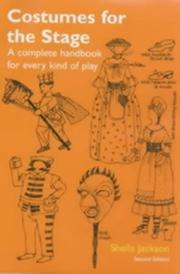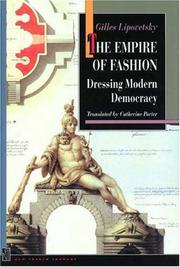| Listing 1 - 10 of 124 | << page >> |
Sort by
|
Periodical
ISSN: 00429945 Publisher: München : Deutscher Kunstverlag,
Abstract | Keywords | Export | Availability | Bookmark
 Loading...
Loading...Choose an application
- Reference Manager
- EndNote
- RefWorks (Direct export to RefWorks)
Arms and armor --- Costume --- Kostuums. --- Fancy dress --- Motion pictures --- Opera --- Stage costume --- Theater --- Theatrical costume --- Decorative arts --- Clothing and dress --- History --- Ethnology. Cultural anthropology

ISBN: 1408148455 1408116901 9781408116906 0713659688 9780713659689 Year: 2020 Publisher: London, England : London, England : A. & C. Black, Bloomsbury Publishing,
Abstract | Keywords | Export | Availability | Bookmark
 Loading...
Loading...Choose an application
- Reference Manager
- EndNote
- RefWorks (Direct export to RefWorks)
For anyone producing costumes on a small budget, whether for schools, colleges or amateur, semi-professional or professional groups, this basic introduction offers practical advice for every kind of play, together with drawings, diagrams and patterns from which to work. It includes sections onm Greek plays, medieval miracles and mysteries, Shakespeare, 17th-century, 18th-century, Victorian and Edwardian costume. each section covers the details of men's and women's clothes and accessories, as well as methods for adapting and simplifying the style of the period.
Performing arts. --- Show business --- Arts --- Performance art --- Costume. --- Fancy dress --- Motion pictures --- Opera --- Stage costume --- Theater --- Theatrical costume --- Decorative arts --- Clothing and dress --- Costume --- Dance & other performing arts
Book
ISBN: 0253015812 9780253015815 9780253015778 0253015774 Year: 2015 Publisher: Bloomington, Indiana : Indiana University Press,
Abstract | Keywords | Export | Availability | Bookmark
 Loading...
Loading...Choose an application
- Reference Manager
- EndNote
- RefWorks (Direct export to RefWorks)
What does it mean to people around the world to put on costumes to celebrate their heritage, reenact historic events, assume a role on stage, or participate in Halloween or Carnival? Self-consciously set apart from everyday dress, costume marks the divide between ordinary and extraordinary settings and enables the wearer to project a different self or special identity. Pravina Shukla offers richly detailed case studies from the United States, Brazil, and Sweden to show how individuals use costumes for social communication and to express facets of their personalities.
Identity (Psychology) --- Costume --- Personal identity --- Personality --- Self --- Ego (Psychology) --- Individuality --- Fancy dress --- Motion pictures --- Opera --- Stage costume --- Theater --- Theatrical costume --- Decorative arts --- Clothing and dress --- Social aspects. --- History.
Book
ISBN: 905875118X Year: 2004 Publisher: Amsterdam : SUN,
Abstract | Keywords | Export | Availability | Bookmark
 Loading...
Loading...Choose an application
- Reference Manager
- EndNote
- RefWorks (Direct export to RefWorks)
Costume --- -Fashion --- -Style in dress --- Clothing and dress --- Fancy dress --- Motion pictures --- Opera --- Stage costume --- Theater --- Theatrical costume --- Decorative arts --- History --- -History --- -Clothing and dress --- Style in dress --- Fashion
Book
ISBN: 832291248X Year: 1995 Publisher: Wroclaw : Wydawnictwo Uniwersytetu Wroclawskiego,
Abstract | Keywords | Export | Availability | Bookmark
 Loading...
Loading...Choose an application
- Reference Manager
- EndNote
- RefWorks (Direct export to RefWorks)
Costume --- -Fancy dress --- Motion pictures --- Opera --- Stage costume --- Theater --- Theatrical costume --- Decorative arts --- Clothing and dress --- -Costume --- Apparel --- Clothes --- Clothing --- Clothing and dress, Primitive --- Dress --- Dressing (Clothing) --- Garments --- Beauty, Personal --- Manners and customs --- Fashion --- Undressing --- Europe --- Costume folklorique --- Folklore scandinave
Book
ISBN: 9789173466851 9173466859 Year: 2010 Publisher: University of Gothenburg : Gothenburg,
Abstract | Keywords | Export | Availability | Bookmark
 Loading...
Loading...Choose an application
- Reference Manager
- EndNote
- RefWorks (Direct export to RefWorks)
Costume --- Silk --- Textile fabrics --- Cloth --- Fabrics --- Textile industry and fabrics --- Textiles --- Decorative arts --- Dry-goods --- Weaving --- Textile fibers --- Animal fibers --- Fancy dress --- Motion pictures --- Opera --- Stage costume --- Theater --- Theatrical costume --- Clothing and dress --- Conservation and restoration
Book
ISBN: 0875871887 Year: 2002 Publisher: Los Angeles Los Angeles County Museum of art
Abstract | Keywords | Export | Availability | Bookmark
 Loading...
Loading...Choose an application
- Reference Manager
- EndNote
- RefWorks (Direct export to RefWorks)
drama [literature] --- Theatrical science --- Japan --- No --- Exhibitions --- Kyogen --- Theater --- Costume --- Masks --- Nō masks --- Nō --- Noh --- Shimai --- Fancy dress --- Motion pictures --- Opera --- Stage costume --- Theatrical costume --- Decorative arts --- Clothing and dress --- drama [discipline] --- Kyogen [volk] --- kyogen

ISBN: 0691033730 0691102627 Year: 2002 Publisher: Princeton, N.J. Princeton University Press
Abstract | Keywords | Export | Availability | Bookmark
 Loading...
Loading...Choose an application
- Reference Manager
- EndNote
- RefWorks (Direct export to RefWorks)
In a book full of playful irony and striking insights, the controversial social philosopher Gilles Lipovetsky draws on the history of fashion to demonstrate that the modern cult of appearance and superficiality actually serves the common good. Focusing on clothing, bodily deportment, sex roles, sexual practices, and political rhetoric as forms of "fashion," Lipovetsky bounds across two thousand years of history, showing how the evolution of fashion from an upper-class privilege into a vehicle of popular expression closely follows the rise of democratic values. Whereas Tocqueville feared that mass culture would create passive citizens incapable of political reasoning, Lipovetsky argues that today's mass-produced fashion offers many choices, which in turn enable consumers to become complex individuals within a consolidated, democratically educated society.Superficiality fosters tolerance among different groups within a society, claims Lipovetsky. To analyze fashion's role in smoothing over social conflict, he abandons class analysis in favor of an inquiry into the symbolism of everyday life and the creation of ephemeral desire. Lipovetsky examines the malaise experienced by people who, because they can fulfill so many desires, lose their sense of identity. His conclusions raise disturbing questions about personal joy and anguish in modern democracy.
Costume --- -Fashion --- -Style in dress --- Clothing and dress --- Fancy dress --- Motion pictures --- Opera --- Stage costume --- Theater --- Theatrical costume --- Decorative arts --- History --- -History --- -Costume --- Fashion --- Political philosophy. Social philosophy --- Sociology of culture
Book
ISBN: 3766703838 Year: 1978 Publisher: München Callwey
Abstract | Keywords | Export | Availability | Bookmark
 Loading...
Loading...Choose an application
- Reference Manager
- EndNote
- RefWorks (Direct export to RefWorks)
Costume --- -Costume --- -Jewelry, Rustic --- -Rustic jewelry --- Folk art --- Fancy dress --- Motion pictures --- Opera --- Stage costume --- Theater --- Theatrical costume --- Decorative arts --- Clothing and dress --- History --- -History --- -Catalogs --- Applied arts. Arts and crafts --- juweelkunst --- Germany --- Austria --- Switzerland --- -Fancy dress --- Rustic jewelry
Book
ISBN: 1317149645 1283090473 9786613090478 140942913X 9781409429135 9780754641520 075464152X 1317149653 1315577569 Year: 2011 Publisher: Burlington, VT : Ashgate Pub. Co.,
Abstract | Keywords | Export | Availability | Bookmark
 Loading...
Loading...Choose an application
- Reference Manager
- EndNote
- RefWorks (Direct export to RefWorks)
Disguise devices figure in many early modern English plays and an examination of them clearly affords an important reflection on the growth of early theatre as well as on important aspects of the developing nation. In this study, Hyland examines various conceptual and practical issues that provide a background to theatrical disguise and goes on to consider a range of plays under three broad headings: moral issues, social issues, and aesthetic issues.
Theater --- Disguise --- Costume --- Fancy dress --- Motion pictures --- Opera --- Stage costume --- Theatrical costume --- Decorative arts --- Clothing and dress --- Deception --- History --- History. --- Stage design. Scenography --- anno 1500-1599 --- anno 1600-1699 --- Great Britain
| Listing 1 - 10 of 124 | << page >> |
Sort by
|

 Search
Search Feedback
Feedback About UniCat
About UniCat  Help
Help News
News